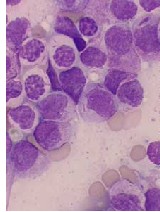
| From Research to Business |
 | |
|
Most genes are not permanently active but rather are only activated at certain times. In every cell of the body there is a program specifying which gene is switched on or off and when exactly this happens. Unfortunately, this program is error-prone. Environmental factors or defects in the DNA sometimes switch off genes that are important for us, as are, for instance, the genes that inhibit uncontrolled cell proliferation or genes that see to it that damage to the DNA is repaired. In many cases a cancer cell develops out of a normal body cell, because important genes have wrongly been turned off.
If it were possible to reactivate these genes, the cancer cell would hopefully turn back into a normal body cell.
And this is where valproic acid comes into the picture.
In fact, vaproic acid has the beneficial characteristic of reactivating certain genes, especially those that are important for the development and maturation of a cell.
NGFN-scientists at the Georg Speyer Haus in Frankfurt/Main and from the Forschungszentrum Karlsruhe have proven that valproic acid activates genes that inhibit the growth of cancer cells. Now the researchers investigate what dosage is suitable for the treatment of cancer patients and how the drug works in combination with other cancer medications.
To further advance clinical trials and to ensure efficient transfer of the research results into drug production and therefore medical practice, the company G2M Cancer Drugs AG was founded. Studies regarding the application for leukemia and colon cancer are already in the preparation phase. "Thanks to the close collaboration of academic and commercial partners, valproic acid could be approved as a new cancer drug in Germany as early as 2007" said Dr. Heinzel who spearheaded the Frankfurt team.
Page 2: How does valproic acid work? How can it turn genes on?
 |
|
This can even be observed by looking through the microscope: cancer cells develop back into normal body cells again. |




